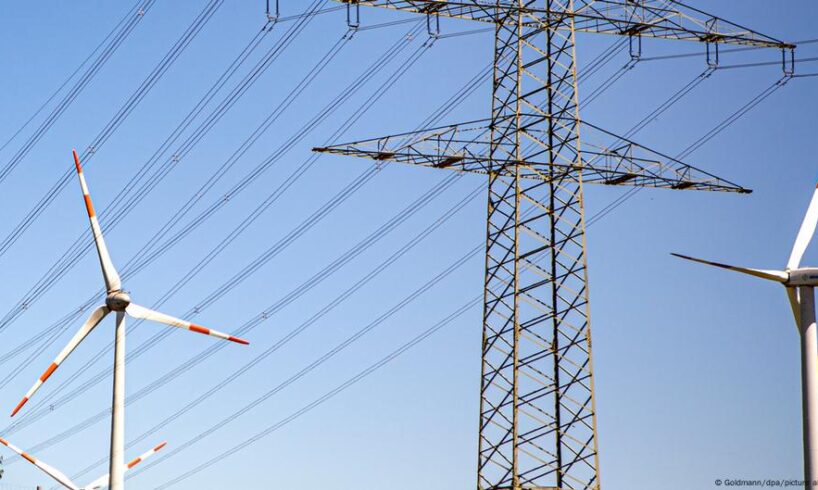
Germany’s so-called new high-voltage electricity highways are growing, but experts say their development is failing to keep up with the country’s rapid growth in renewable energy.
As the wind-rich north of Germany produces ever-increasing volumes of renewable energy in onshore and offshore wind parks, the country’s southern regions, where most industrial companies are situated, are craving for electricity, still heavily relying on gas or coal-fired power plants and a bit of solar energy.
Almost two decades ago, four transmission system operators (TSOs) were tasked by the German government with building new power lines from north to south.
Being responsible for Germany’s high-voltage grid, TSOs maintain, operate, plan and expand grid infrastructure.
For example, 50Hertz Transmission — owned by Belgian company Elia Group (80%) and German state-owned KfW banking group (20%) — controls the grid in eastern Germany and parts of it in the north. German TSO Amprion is responsible for an 11,000 kilometer (6,800 mile) grid that spans from northern Germany to the Alps in the south. Then, there is TransnetBW in southwestern Germany, and Dutch state-owned TenneT — Europe’s biggest TSO.
Germany’s regulator, the Federal Network Agency, has defined five steps these companies must follow before construction can begin.
It starts with the development of a “scenario framework” in which the TSOs outline the likely evolution of energy supply and demand. Next, they must prepare a “grid development plan” and submit an “environmental report.” In the third step, a “federal requirement plan” is created, followed by a “spatial planning procedure” in the fourth. The final step is the official “planning approval process.”
Even after that, construction doesn’t immediately begin. The Federal Network Agency — or a relevant regional authority — must still carry out a final “environmental impact assessment.”
Progress on grid expansion hampered by setbacks
Germany’s Power Grid Expansion Act, known as EnLAG, came into force in 2009, and is intended to accelerate the expansion of the power grid to support the transition to renewable energy sources.
According to the Federal Network Agency, the regulation calls for around 128 construction projects totaling 16,832 kilometers of power lines by the end of 2024. However, a total of only 34 projects have been “fully completed” until now, the agency said in a statement to DW.
What’s even more astonishing is that the German regulator expects construction to continue for another eight to 20 years — unless new projects are added.
In order to speed up the expansion, the agency’s president, Klaus Müller, told German business daily Handelsblatt in May that the system “by which grid fees are collected” would need to be reformed.
Due to public pressure, some regional German governments want to see cables laid underground which is costly and time-consumingImage: Carsten Rehder/dpa/picture alliance
The charges for using the electricity grid, paid solely by consumers, have been steadily rising in recent years, and now make up about a quarter of electricity bills, varying by region. Müller suggested that grid fees in the future should also be paid by power plant operators and renewable energy providers.
Although public resistance to grid expansion has been relatively low-key and so far limited to local pressure groups, the government fears that further rising electricity bills may erode support, leading to more protests and delays in the courts.
Could the expansion go faster?
Setting a firm timeline for when the expansion of Germany’s high-voltage grid will be complete isn’t realistic.
TenneT spokesperson Maria Köhler thinks grid expansion is “not a task that will be completed at a specific point in time.” She told DW that it was “an ongoing process” toward a climate-neutral network, with a “target year of 2037 and an extended outlook through 2045.”
Why Germany’s grid rejects the gift of summer
To view this video please enable JavaScript, and consider upgrading to a web browser that supports HTML5 video
Some grid operators, however, are planning to move faster.
50Hertz Transmission, for example, has more ambitious goals, according to company spokesperson Karin Dietl.
“In our grid area, we want to fully integrate 100% renewable energy into the grid and system by 2032,” she said in an email statement to DW.
Dietl also pointed to the impediments that would hinder a more rapid expansion pace, such as “a shortage of skilled labor, supply bottlenecks, and lengthy approval processes.”
TenneT cited similar issues, saying that in this “technically and organizationally complex undertaking,” many factors come into play — ranging from “regulatory approvals and coordination with authorities over land access to materials supply, transportation logistics, and workforce capacity.”
TransnetBW emphasized one issue in particular. “The biggest obstacles in the past have been long and burdensome approval procedures,” spokesperson Claudia Halici told DW, citing the so-called SuedLink power line project as an example, for which “planning and approval took about seven years.”
Marta Mituta, spokeswoman for the Federal Network Agency, agreed, adding “last-minute changes to temporary infrastructure, species protection measures, or updated results from alternative route assessments” to the stumbling blocks.
Why is it all so expensive?
Most of Germany’s green electricity — particularly wind power — is produced in the wind-rich north of the country. In addition, renewable electricity from Denmark and Norway arrives in the country via subsea power lines and needs to flow further down south to major industrial consumers.
Although Germany managed to largely cut its dependence on Russian gas and oil in a surprisingly short time, achieving energy autonomy remains a critical government goal along the way to become carbon-neutral by 2045.
Apart from that, the focus of public debate has increasingly moved technical issues, such as the question of whether or not power lines can run above ground or must be buried underground.
Few Germans are willing to accept living underneath or close to overhead power linesImage: picture-alliance/dpa/P. Steffen
Local communities are vehemently opposed to overhead power lines in their vicinity. In addition, the lines are exposed to storms, snow, and military risks. By contrast, underground cables don’t mar the landscape and are more protected from attacks — but they’re far more expensive. Grid operators have a clear preference, though.
“TransnetBW has long advocated ending the blanket preference for underground cables in new high-voltage direct-current projects,” Claudia Halici, told DW, adding the company expected “savings of €20 to €23 billion [$23.2 to $26.7 billion]” alone for its three transmission line projects currently under construction — about a 50% reduction in total costs.
Katrin Dietl from 50Hertz also anticipates €20 billion in savings. “That’s why 50Hertz is pushing for a shift to overhead lines in new projects,” she said, however, cautioning against “changing course midstream,” as this would cause “significant delays” to already approved projects.
This article was originally written in German.





